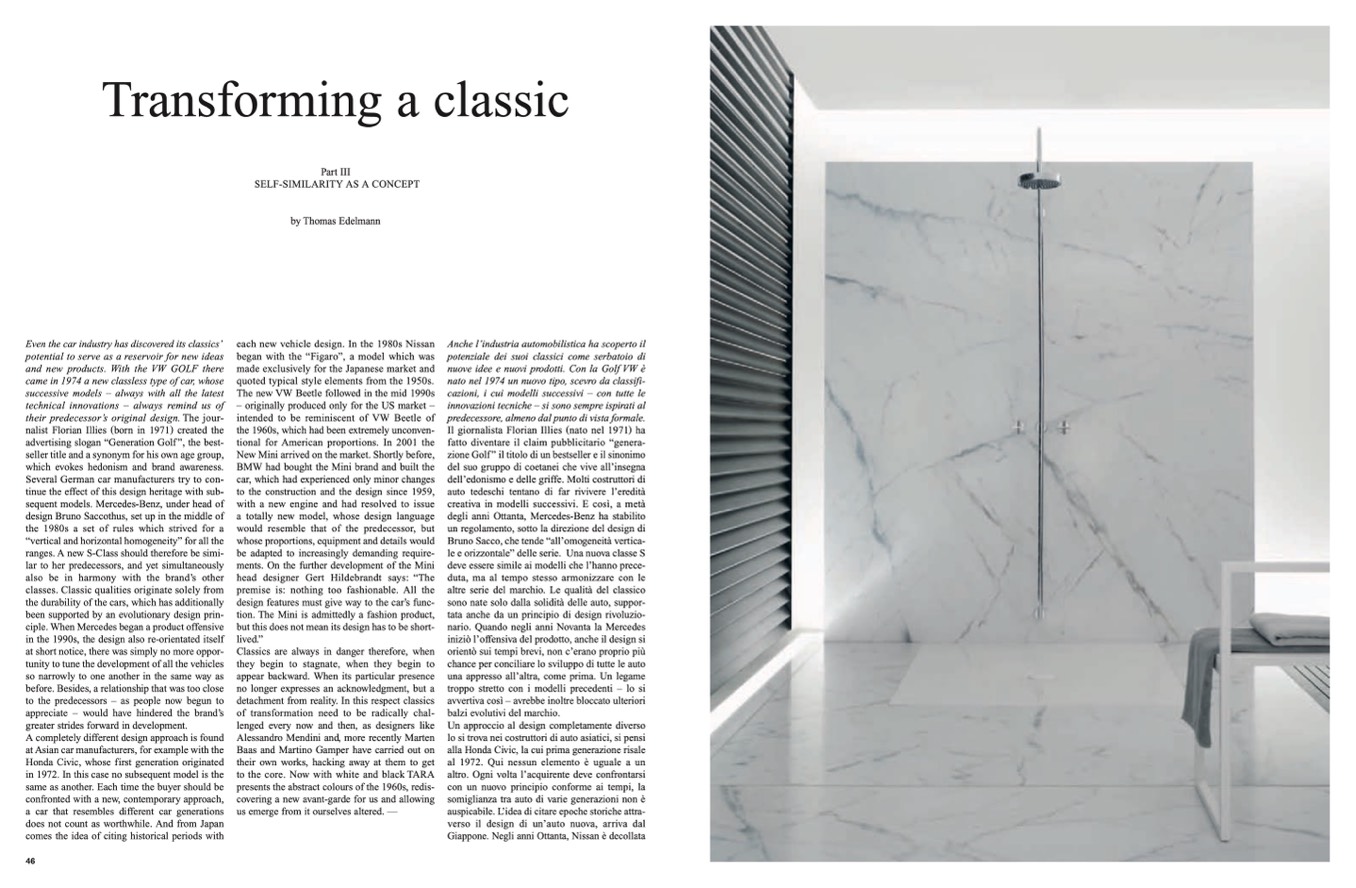
46
Transforming a classic
Even the car industry has discovered its classics’
potential to serve as a reservoir for new ideas
and new products. With the VW GOLF there
came in 1974 a new classless type of car, whose
successive models – always with all the latest
technical innovations – always remind us of
their predecessor’s original design. The jour-
nalist Florian Illies (born in 1971) created the
advertising slogan “Generation Golf ”, the best-
seller title and a synonym for his own age group,
which evokes hedonism and brand awareness.
Several German car manufacturers try to con-
tinue the effect of this design heritage with sub-
sequent models. Mercedes-Benz, under head of
design Bruno Saccothus, set up in the middle of
the 1980s a set of rules which strived for a
“vertical and horizontal homogeneity” for all the
ranges. A new S-Class should therefore be simi-
lar to her predecessors, and yet simultaneously
also be in harmony with the brand’s other
classes. Classic qualities originate solely from
the durability of the cars, which has additionally
been supported by an evolutionary design prin-
ciple. When Mercedes began a product offensive
in the 1990s, the design also re-orientated itself
at short notice, there was simply no more oppor-
tunitytotunethedevelopmentofallthevehicles
so narrowly to one another in the same way as
before. Besides, a relationship that was too close
to the predecessors – as people now begun to
appreciate – would have hindered the brand’s
greater strides forward in development.
A completely different design approach is found
at Asian car manufacturers, for example with the
Honda Civic, whose f irst generation originated
in 1972. In this case no subsequent model is the
same as another. Each time the buyer should be
confronted with a new, contemporary approach,
a car that resembles different car generations
does not count as worthwhile. And from Japan
comes the idea of citing historical periods with
Part III
SELF-SIMILARITY AS A CONCEPT
by Thomas Edelmann
each new vehicle design. In the 1980s Nissan
began with the “Figaro”, a model which was
made exclusively for the Japanese market and
quoted typical style elements from the 1950s.
The new VW Beetle followed in the mid 1990s
– originally produced only for the US market –
intended to be reminiscent of VW Beetle of
the 1960s, which had been extremely unconven-
tional for American proportions. In 2001 the
New Mini arrived on the market. Shortly before,
BMW had bought the Mini brand and built the
car, which had experienced only minor changes
to the construction and the design since 1959,
with a new engine and had resolved to issue
a totally new model, whose design language
would resemble that of the predecessor, but
whose proportions, equipment and details would
be adapted to increasingly demanding require-
ments. On the further development of the Mini
head designer Gert Hildebrandt says: “The
premise is: nothing too fashionable. All the
design features must give way to the car’s func-
tion. The Mini is admittedly a fashion product,
but this does not mean its design has to be short-
lived.”
Classics are always in danger therefore, when
theybegintostagnate,whentheybeginto
appear backward. When its particular presence
no longer expresses an acknowledgment, but a
detachment from reality. In this respect classics
of transformation need to be radically chal-
lenged every now and then, as designers like
Alessandro Mendini and, more recently Marten
Baas and Martino Gamper have carried out on
their own works, hacking away at them to get
to the core. Now with white and black TARA
presents the abstract colours of the 1960s, redis-
covering a new avant-garde for us and allowing
us emerge from it ourselves altered. —
Anche l’industria automobilistica ha scoperto il
potenziale dei suoi classici come serbatoio di
nuove idee e nuovi prodotti. Con la Golf VW è
nato nel 1974 un nuovo tipo, scevro da classifi-
cazioni, i cui modelli successivi – con tutte le
innovazioni tecniche – si sono sempre ispirati al
predecessore, almeno dal punto di vista formale.
Il giornalista Florian Illies (nato nel 1971) ha
fatto diventare il claim pubblicitario “genera-
zione Golf ” il titolo di un bestseller e il sinonimo
del suo gruppo di coetanei che vive all’insegna
dell’edonismo e delle griffe. Molti costruttori di
auto tedeschi tentano di far rivivere l’eredità
creativa in modelli successivi. E così, a metà
degli anni Ottanta, Mercedes-Benz ha stabilito
un regolamento, sotto la direzione del design di
Bruno Sacco, che tende “all’omogeneità vertica-
le e orizzontale” delle serie. Una nuova classe S
deve essere simile ai modelli che l’hanno prece-
duta, ma al tempo stesso armonizzare con le
altre serie del marchio. Le qualità del classico
sono nate solo dalla solidità delle auto, suppor-
tata anche da un principio di design rivoluzio-
nario. Quando negli anni Novanta la Mercedes
iniziò l’offensiva del prodotto, anche il design si
orientò sui tempi brevi, non c’erano proprio più
chanceperconciliarelosviluppoditutteleauto
una appresso all’altra, come prima. Un legame
troppo stretto con i modelli precedenti – lo si
avvertiva così – avrebbe inoltre bloccato ulteriori
balzi evolutivi del marchio.
Un approccio al design completamente diverso
lo si trova nei costruttori di auto asiatici, si pensi
alla Honda Civic, la cui prima generazione risale
al 1972. Qui nessun elemento è uguale a un
altro. Ogni volta l’acquirente deve confrontarsi
con un nuovo principio conforme ai tempi, la
somiglianza tra auto di varie generazioni non è
auspicabile.L’ideadicitareepochestoricheattra-
verso il design di un’auto nuova, arriva dal
Giappone. Negli anni Ottanta, Nissan è decollata

